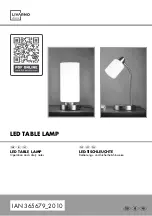
3. Connecting the light fixture
Warning:
Always consult a qualified electrician when connecting OceanLED light
fixtures. When connecting light units, please note that all OceanLED lights will
operate within a specific voltage range.
OceanLED Sport models require a 12/24v DC supply. This supply should be a
minimal 6A @ 12vDC or 3A @ 24v DC per light.
When connecting lights to your V DC power source it is recommended to connect
using a two pole screw type terminal block, with a minimum voltage rating of
50V and a current rating of at least 6A. (When installing multiple fixtures we
recommend using the OceanLED 4 way Power Junction Box). The ends of the
cable should be stripped back (if required) and suitable ferrules fitted. The
terminal block should be fixed inside a waterproof enclosure (IP66 minimum).
Tip:
Switch and breaker need to have sufficient current ratings to support light.
For complete instructions on V DC connections, please refer to ABYC codes of
practice and other applicable codes and ordinances for V DC connections.
Warning:
Never leave the bare cables unprotected. Take care to not leave the
bare wire ends in bilge water before making the waterproof connections. Water
deposits in the connectors and cables will cause corrosion. Over time water can
also work its way into the unit along the inside of the cable due to capillary action
causing the light to fail. This will NOT be covered under warranty.
1.
Depending on the quantity of lights installed you will need to pull the
correct sized power cable
from the breaker/fuse panel to the light locations
to supply constant power to the units. It is imperative that the correct
sized tinned marine cable is used. For recommened cable guages see full
installation manual, available online.
2.
If you are not installing a custom fuse panel, it is imperative that the
OceanLED supplied fuse is installed on the power line from each light.
3.
Using waterproof connections or IP66 waterproof junction boxes, make
the connections from the fused V DC power source(s) to the light(s). If
appropriate always use a dielectric grease when making the connections
and make sure any heat shrink used completely encapsulates the outer wire
sheath (the use of glue-lined heat shrink is highly recommended to ensure
water tightness).
NOTE:
Corrosion of wire, and/or water ingress into the light unit via the cable
is NOT covered under warranty.
4.
Secure cabling ensuring where the cable exits the light it is not under stress.


























